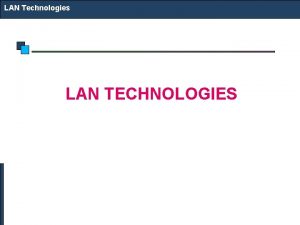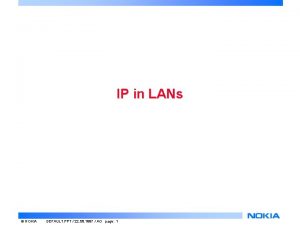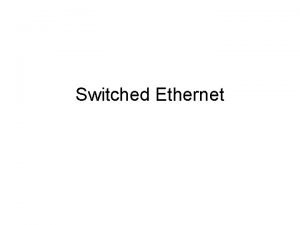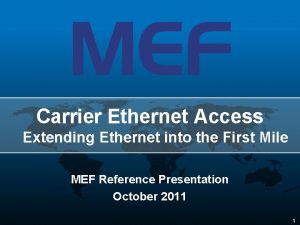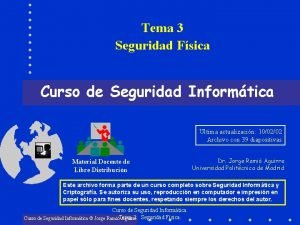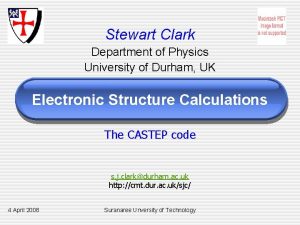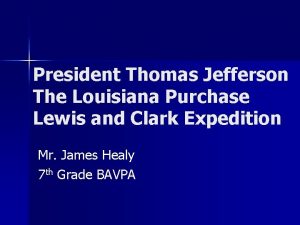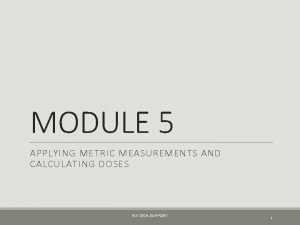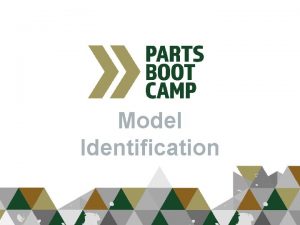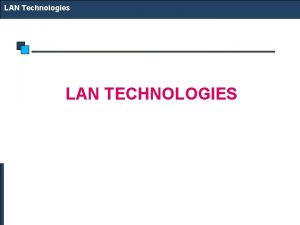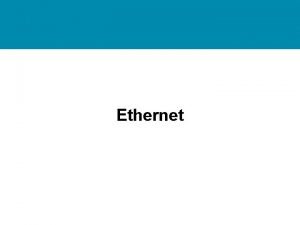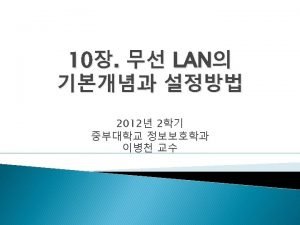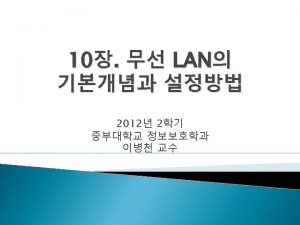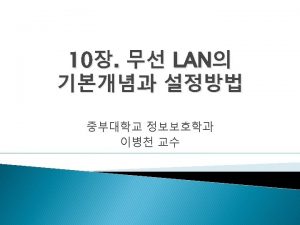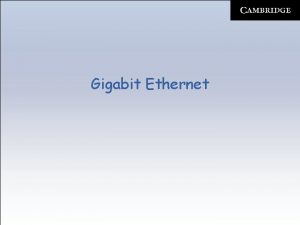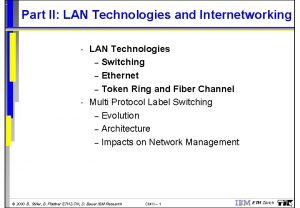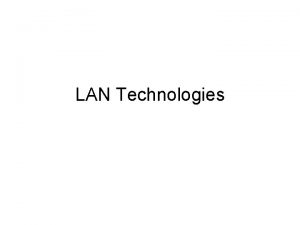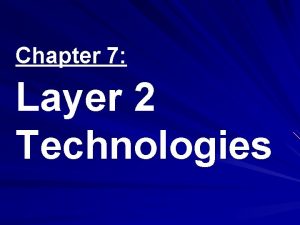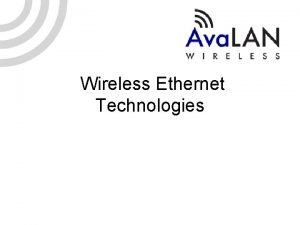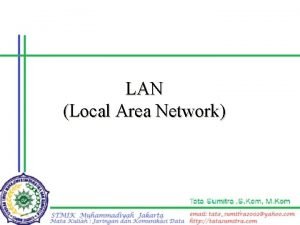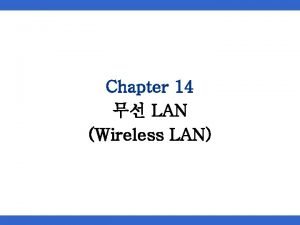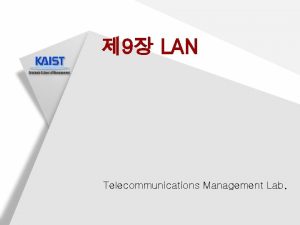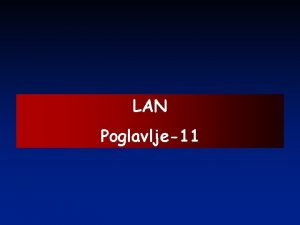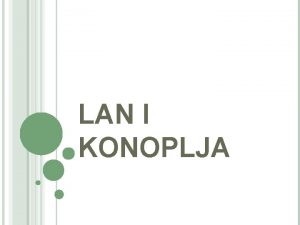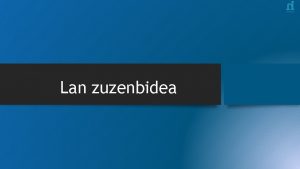Ethernet LAN Technologies John A Clark Ethernet Here



















- Slides: 19

Ethernet LAN Technologies John A. Clark Ethernet - Here to Stay

Agenda £ Early History £ Ethernet Vs Token Ring £ Structured Cabling £ Fast Ethernet £ Gigabit Ethernet £ Gig. E Vs ATM Ethernet - Here to Stay

Early History ALOHAnet - Norman Abrahamson, University of Hawaii First packet radio network, circa 1970 Several island transmitters communicated reliably to a central station u Had to deal with contention on the radio channel u Multiple stations attempting to transmit at once i. e. “a collision” u Packet transmissions repeated where collisions occurred u Remains in use today for "many to one" telecommunication applications e. g. GSM digital cellular standards … became the basis for Ethernet u Name coined 1972 - Luminiferous “Ether” … Was though to be the passive medium, through which electromagnetic waves could propagate, like water ripples, before the work of 20 th century physics Ethernet - Here to Stay

Early History Robert Metcalfe - Inventor of Ethernet Also famous for founding a network/palm-top vendor! u u u Bob Metcalfe's Harvard Ph. D Thesis outlines idea for Ethernet Experimental version at Xerox PARC - Paulo Alto Research Centre in 1972, focussed on coaxial cable shared transmission medium Metcalfe, Boggs et al patent 1975 DEC, Intel & Xerox - Ethernet Version 1. 0 (1980) & 2. 0 (1982) IEEE 802. 3 standard 1983 Ethernet - Here to Stay

Early History Experimental Ethernet - “Ironing out the bugs”! Changes in the Version 1. 0 specification and were based upon the experiences with the 1 st generation Ethernet Data Rate Max Network Span Max Segment Length Encoding Type Coax Cable Impedance Signalling Levels Preamble Length CRC Length Address Length Experimental Version 1. 0 2. 94 Mbps 1 Km Manchester 75 ohms 0 to +3 volts 1 bit 16 bits 8 bits 10 Mbps 2. 5 Km 500 m Manchester 50 ohms 0 to -2 volts 64 bits 32 bits 48 bits First generation successfully proved concept … ran between two computers called Michelson and Morley, who proved “Ether” did not exist! Ethernet - Here to Stay

Early History CSMA/CD - Carrier Sense Multiple Access/ Collision Detect u u u Carrier sensing & collision detection added to ALOHAnet scheme Accumulation of -0. 9 volt D. C. “carrier” voltage on coax All collisions must be detected within propagation time of min size packet, 64 bytes (512 bits) = 51. 2 usec at 10 Mbps … the Slot Time Minimum inter-packet gap of 9. 6 usec 32 bit jam - collision consensus enforcement … to flood entire segment Ethernet - Here to Stay

Early History Truncated Binary Exponential Back-off Algorithm Random retransmission delay before retrying after collision u u A maximum of 16 retries are allowed Delay on the nth attempt is a random number of slot times (51. 2 usec) between 0 and 2 n Holds until the 11 th retry (n=10), when the random delay is truncated to a value between 0 and 210 (1024) slot times Fairly resolves contention amongst up to 1024 stations 32 Bit CRC (Cyclic Redundancy Check) Error detection G(x)=x 32+x 26+x 23+x 22+ x 16+x 12+x 11+x 10+ x 8+x 7+x 5+x 4+ x 2 +x+1 u The binary number from the Destination, Source, Length(Type) and Data fields is divided by the result of cycling the last CRC through the polynomial G(x) u The remainder is placed in the CRC field, following the data. u During checking a recalculated CRC is- XOR’d check for a 0 remainder Ethernet Here toto. Stay

Ethernet Vs Token Ring IEEE 802. 5 Token Ring u u Signals travel around the network from one station to the next, the cabling forming a logical ring Networks originally operated at 4 Mbps, increasing to 16 Mbps Access method on token ring networks is by token passing Ensures only one station can transmit at a time Ethernet - Here to Stay

Ethernet Vs Token Ring IEEE 802. 3 Ethernet · · · · 10 Mbps CSMA/CD - statistical access Approx 40% bandwidth efficiency 1518 Max frame size No inherent resilience at Physical level Cost effective to deploy Rapid advances in technology IEEE 802. 5 Token Ring · · · · 4/16 Mbps Token passing deterministic access Up to 90% efficiency little drop in response time 15 K+ MTU size Self-healing beaconing process Higher equipment costs Slower development of standards & products Ethernet - Here to Stay

Ethernet Vs Token Ring Market Trends do not always follow technoloy (VHS Vs Betamax!) u u Industry analysis has shown that Ethernet continued to win the battle of the desktop technologies Token Ring really only significant in vertical markets Ethernet - Here to Stay

Structured Cabling Ethernet over twisted pair “telephone cable” !! Thicknet 10 Base 5, Thinnet 10 base 2, optic fibre 10 Base. F u AT&T Systimax PDS (Premisis Distribution System) u Flood wiring of new buildings, grid pattern outlets per sq metre u u u Ronald Schmidt, technical director of Syn. Optics, creator of the Ethernet 10 base. T standard 10 megabits of baseband data over twisted pair Network Type 10 BASE 5 10 BASE 2 10 BASE-FL 10 BASE-T Max Nodes Per Segment 100 30 2 2 Max Distance Per Segment 500 m 185 m 2000 m 100 m Ethernet - Here to Stay

Fast Ethernet Same Ethernet but 10 times faster !! IEEE 802. 3 u 100 Base. T Standard approved in 1995 Employs original Ethernet CSMA/CD access method 100 Base. T supports 3 physical layers: 100 Base. Tx: two pair system for Category 5 cabling 100 Base. T 4: four pair system for Category 3, 4 and 5 cable 100 Base. Fx: A two strand optic fibre Ethernet - Here to Stay

Gigabit Ethernet 1000 Mbps Ethernet !! u 1996 Gigabit Ethernet developed IEEE 802. 3 z approved 1997 Leonard Kleinrock of UCLA helped define the mathematical limits of Ethernet, and for naming CSMA/CD). Ethernet - Here to Stay

Gigabit Ethernet Standards Modifications u u u u CSMA/CD method enhanced to maintain 200 m collision diameters Carrier time and Ethernet Slot Time extended from 64 bytes (512 bits) to 512 bytes (4096 bits) = 4. 096 usec Without this change, minimum sized frames could be transmitted before CSMA/CD could detect a collision Packets smaller than 512 bytes (min still 64 bytes) have a carrier extension to 512 bytes Adversely affects small packet performance - new facility in CSMA/CD called packet bursting to allow switches/server to send multiple small packets Switches operating in full-duplex mode do not need carrier/slot time extension or packet bursting Differential Mode Delay (DMD) problems with laser launch on 62. 5 micron optic fibre Ethernet - Here to Stay

Gig. E Vs ATM Network Speed/Distance · · · Gigabit-Ethernet 1000 Base. CX: 25 m 1000 Base. SX: 500 m on 50 micron MM fibre, 160 m on 62. 5 micron (DMD) 1000 Base. LX: 550 m all MM fibre , 3 km SM fibre 1 Gbps limit Network Diameter Restrictions when Shared · · · ATM 25 Mbps 155 Mbps - OC 3 c 622 Mbps - OC 12 c 800 m MM/15 km SM 2. 4 Gbps - OC 48 c … no theoretical limit No Network Diameter Restrictions Ethernet - Here to Stay

Gig. E Vs ATM Network Resilience Gigabit-Ethernet · · · Spanning Tree Protocol blocks parallel links stability issues? No standards based loadsharing - Mostly proprietary Use of OSPF / RIP with Layer 3 switching ATM · · · Build-in Redundancy Parallel Load-sharing links for resilience & aggregate bandwidth Full Meshed Topologies Ethernet - Here to Stay

Gig. E Vs ATM Standards Required Gigabit-Ethernet · · · 802. 3 z (1000 Base. LX/SX/CX) 802. 3 ab (1000 Base. TX) 802. 3 x (Flow Control), Standard since 3/97 802. 1 P (Prioritisation) 802. 1 Q (Vlan Queuing) RSVP (Resource re. Ser. Vation Protocol), RFC 2205 ATM · · · LANE 1. 0 IISP (PNNI Ph 0) PNNI LANE 2. 0 MPOA 1. 0 NHRP Ethernet - Here to Stay

Gig. E Vs ATM Routing/Layer 3 Switching Gigabit-Ethernet · · · Routing via high 100/1000 Mbps links VLAN trunks with IEEE 802. 1 Q coming Layer 3 hardware routing switches with n Mbps throughout/ n usec latency ATM · · · Routing via high 100 Mbps links (1000 Mbps to follow) VLAN trunks with ATM VNR proven Layer 3 switching via ATM Forum MPOA (Nortel/Bay) rolling out during Q 199 Ethernet - Here to Stay

Conclusions Ethernet has evolved at a very rapid rate, 10 Mbps … 1000 Mbps - this is likely to continue Ethernet - Here to Stay
 Functions of marketing by clark and clark
Functions of marketing by clark and clark Lan technologies
Lan technologies Lan technologies ppt
Lan technologies ppt Switched ethernet vs shared ethernet
Switched ethernet vs shared ethernet Microwave technologies for carrier ethernet services
Microwave technologies for carrier ethernet services There's a place where streams of grace
There's a place where streams of grace Monica terapia clark
Monica terapia clark Westward expansion lewis and clark
Westward expansion lewis and clark Níveis de prevenção leavell e clark odontologia
Níveis de prevenção leavell e clark odontologia Evette castillo clark
Evette castillo clark Luke trainer clark the boy who cried wolf
Luke trainer clark the boy who cried wolf Modelo clark wilson
Modelo clark wilson Stewart clark durham
Stewart clark durham The ron clark story
The ron clark story M. ft. ung
M. ft. ung Where did lewis and clark start
Where did lewis and clark start Rumus young dilling
Rumus young dilling Mercaptapurine
Mercaptapurine Young rule
Young rule Nissan forklift data plate
Nissan forklift data plate

